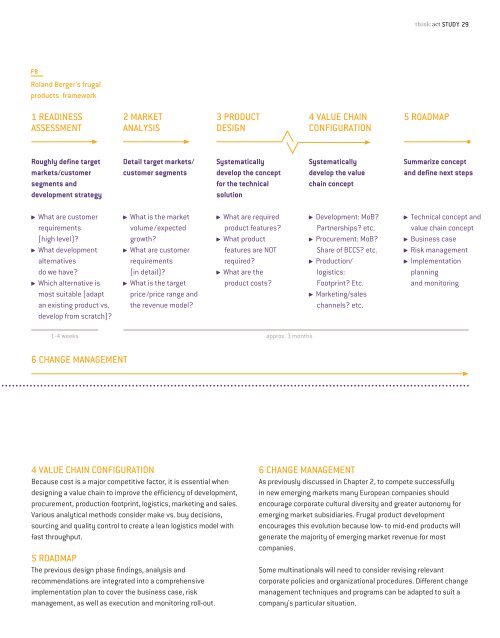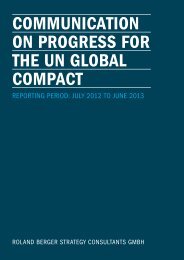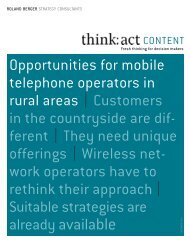PDF, 2492 KB - Roland Berger Strategy Consultants
PDF, 2492 KB - Roland Berger Strategy Consultants
PDF, 2492 KB - Roland Berger Strategy Consultants
- No tags were found...
You also want an ePaper? Increase the reach of your titles
YUMPU automatically turns print PDFs into web optimized ePapers that Google loves.
Study 29F8<strong>Roland</strong> <strong>Berger</strong>'s frugalproducts framework1 ReadinessAssessment2 MarketAnalysis3 ProductDesign4 Value ChainConfiguration5 RoadmapRoughly define targetmarkets/customersegments anddevelopment strategyDetail target markets/customer segmentsSystematicallydevelop the conceptfor the technicalsolutionSystematicallydevelop the valuechain conceptSummarize conceptand define next stepsWhat are customerrequirements(high level)?What developmentalternativesdo we have?Which alternative ismost suitable (adaptan existing product vs.develop from scratch)?What is the marketvolume /expectedgrowth?What are customerrequirements(in detail)?What is the targetprice /price range andthe revenue model?What are requiredproduct features?What productfeatures are NOTrequired?What are theproduct costs?Development: MoB?Partnerships? etc.Procurement: MoB?Share of BCCS? etc.Production/logistics:Footprint? Etc.Marketing/saleschannels? etc.Technical concept andvalue chain conceptBusiness caseRisk managementImplementationplanningand monitoring1-4 weeks approx. 3 months6 Change Management4 Value chain configurationBecause cost is a major competitive factor, it is essential whendesigning a value chain to improve the efficiency of development,procurement, production footprint, logistics, marketing and sales.Various analytical methods consider make vs. buy decisions,sourcing and quality control to create a lean logistics model withfast throughput.5 RoadmapThe previous design phase findings, analysis andrecommendations are integrated into a comprehensiveimplementation plan to cover the business case, riskmanagement, as well as execution and monitoring roll-out.6 Change managementAs previously discussed in Chapter 2, to compete successfullyin new emerging markets many European companies shouldencourage corporate cultural diversity and greater autonomy foremerging market subsidiaries. Frugal product developmentencourages this evolution because low- to mid-end products willgenerate the majority of emerging market revenue for mostcompanies.Some multinationals will need to consider revising relevantcorporate policies and organizational procedures. Different changemanagement techniques and programs can be adapted to suit acompany's particular situation.
















